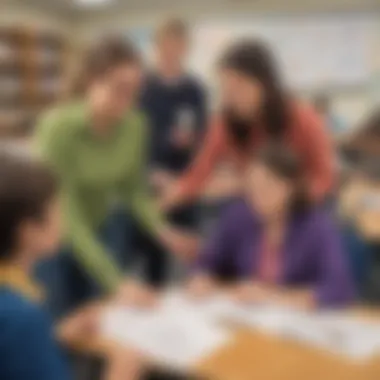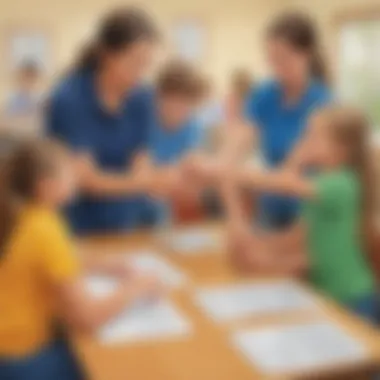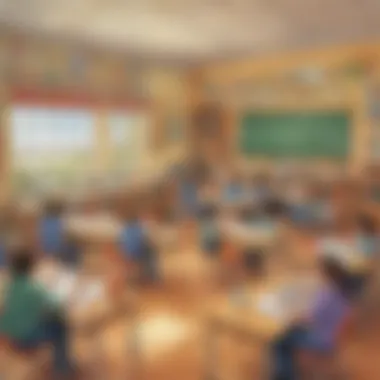Building Strong Teacher-Student Relationships: Activities


Intro
Building strong relationships between teachers and students is crucial in a learning environment. The connections formed can greatly impact engagement and the overall educational experience. However, making these relationships flourish requires intentional effort from educators. Effective activities designed to bridge the gap can foster trust, enhance communication, and develop a more engaging classroom culture. In this section, we emphasize how various practical activities can significantly enhance teacher-student dynamics, particularly in elementary settings.
Creative Activities
Craft Ideas
Creative crafts can be a powerful tool in bringing students and teachers closer. These activities not only allow for self-expression but also help in building rapport. Simple projects using materials readily available can lead to delightful results. For instance, creating personalized bookmarks can be an engaging craft where each student designs something meaningful to them, while sharing ideas ultimately builds a sense of community in the classroom.
Step-by-Step Guides
- Personalized Bookmarks:
- Materials Needed: Cardstock, markers, stickers, scissors, and ribbon.
- Instructions:
- Cut cardstock into rectangular shapes.
- Allow students to draw or color on one side, decorating as they wish.
- Attach a ribbon to make it more appealing.
- Have a sharing session where each student explains their design.
This method promotes creativity and adds a discussion element, turning a simple craft into a relationship-building experience.
Educational Value
Engaging in creative activities translates into multiple educational benefits. First, developing fine motor skills is vital, especially for young children. Second, working on projects as a class encourages teamwork, helping students learn how to collaborate effectively. Last, sharing their creation helps enhance speaking skills while making the classroom setting feel supportive and welcoming.
Fun Quizzes
Quiz Topics
Another means to build connections is through fun, themed quizzes. The topics could range from general knowledge to specific curriculum content. Popular topics include:
- Animals and their habitats.
- Historical figures.
- Basic math tools. Each quiz not only serves as a learning exercise but creates opportunities for teachers to interact with students positively.
Question Types
Using various question types can sustain engagement among students. Options like multiple-choice, true or false, or fill-in-the-blank can cater to different learning styles. The inclusion of visuals can additionally aid understanding.
Knowledge Reinforcement
Quizzes serve as an excellent way to reinforce knowledge. Through collective review after each quiz, teachers can lead discussions that enhance comprehension. Exchanging experiences or mistakes fosters a collaborative atmosphere where students feel comfortable. This teamwork naturally strengthens bonds between teachers and learners.
Fact-Based Articles
Topics
Incorporating fact-based articles provides a wealth of information that aids both instructors and students. Topics can range from science experiments to cultural studies, yielding a well-rounded approach to education.
Engaging Content
These articles should be crafted in a way that the content remains engaging. Focused Nik So exercise good three whp interests to captivate readers. Breaking down information keeps it accessible and ensures relatability through practical examples coupled with references.
Prolusion to Teacher-Student Relationships
Building strong teacher-student relationships is a central theme in education. These connections establish a foundation for meaningful engagement and learning experiences. When educators prioritize their interactions with students, the entire educational environment improves. Classes become not just spaces for learning but communities where trust and respect thrive.
Importance of Relationships in Education
The significance of relationships in educational settings cannot be overstated. Research indicates that positive teacher-student connections contribute to higher student engagement and better academic outcomes. When students feel valued and understood, they often show increased motivation to learn. Relationships act as a catalyst that nurtures a student’s emotional well-being.
Moreover, when teachers support their students on an individual level, they can address diverse learning needs more effectively. This personalized approach cultivates a safe space where young learners can express themselves freely. Parents and caregivers also play a critical role by reinforcing the importance of positive relationships between children and educators.
- Trust fosters a sense of security in students.
- Communication leads to enhanced understanding of children’s strengths and areas for growth.
- Active support can significantly lower anxiety in learners, allowing them to engage more fully in classroom activities.
Effective educator-student relationships are essential for creating a thriving classroom atmosphere which considers not just academia, but the emotional aspects of learning as well.
Current Trends in Teacher-Student Dynamics
Teacher-student dynamics are evolving in numerous ways. With the advance of technology, interactions increasingly extend beyond the traditional classroom setting. The use of digital platforms allows for continuous communication, promoting informal avenues for dialogue and feedback.


Educators today recognize the importance of cultural relevance and responsive teaching. They strive to understand the backgrounds and experiences of their students, fostering inclusive environments that celebrate diversity.
Additionally, there is a growing emphasis on social-emotional learning (SEL). This approach helps students to develop self-awareness and interpersonal skills. Such naturally supportive environments nurture deeper relationships through mutual respect and shared understanding.
In this rapidly changing landscape of education, one thing remains clear—strong teacher-student relationships form the backbone of effective and enriching learning experiences. All stakeholders must recognize their significance and aim to enhance these connections systematically.
Understanding Relationship Building
Strong teacher-student relationships are pivotal for a productive learning environment. When both parties engage meaningfully, the learning experience becomes richer. Teachers who understand how to build these relationships will find that students are often more responsive. This concept extends beyond merely creating rapport; it encompasses understanding each student's unique needs, fostering an atmosphere of trust, and motivating learners effectively.
Effective relationship building requires several components. Recognizing and integrating these elements invites collaboration and growth. The establishing of trust and mutual respect is a two-way street. Students become more willing to participate when they observe their teacher values and respects them. Additionally, a real connection provides a foundation whereby constructive feedback can be given. This method of communication encourages students to improve while feeling supported.
However, relationship building is not influenced solely by individual actions. A range of factors can affect teacher-student interactions. Awareness of these factors might help educators navigate their classroom dynamics more effectively. Continuous engagement through strategies that match students’ varied backgrounds and experiences is central to nurturán those bonds.
Key Components of Effective Relationships
Building effective relationships contains core components such as trust, communication, and empathy. Trust serves as the foundation; without it, a learning relationship risks crumbling. Trust can manifest through consistent behavior and showing integrity in all dealings. Teachers need to be honest and dependable.
Communication is also critical. Both students and teachers must feel free to express their thoughts, concerns, and ideas. Encouragement of dialogue regarding classroom topics can be particularly effective and lessens potential misunderstandings. Finally, empathy strengthens the bonds. Understanding students’ personal circumstances, both inside and outside of the classroom, promotes an environment where authenticity thrives.
Factors Affecting Teacher-Student Interactions
Several external and internal factors influence how teachers and students interact. These aspects include:
- Cultural Background: Different cultures might shape how students perceive authority or communicate. This nuance should be recognized and taken into account by educators.
- Classroom Dynamics: Size and composition influence interactions, too. A crowded classroom may limit individual attention, affecting perceived value for each student.
- Social-Emotional Development: Students at the same grade level can show variability in emotional maturity. Teachers must gauge these levels to react appropriately.
In closing, understanding these components and factors establishes a substantial groundwork for relationship building in education. Careful reflection and application can lead to fruitful interactions that enhance both teaching and learning, making it pertinent in today’s educational environment.
Activities to Enhance Relationships
Building strong teacher-student relationships is crucial in fostering an engaging and effective educational atmosphere. Activities that enhance these relationships offer varied benefits, establishing trust and improving communication. Evidence shows that when students feel known and respected, they are more likely to engage actively in learning. Moreover, structured activities enable educators to identify student needs and develop tailored approaches that suit diverse learning styles. By incorporating these activities in the classroom, teachers set the foundation for positive interactions that build a robust educational environment.
Icebreaker Activities for the Classroom
Icebreaker activities serve as essential tools to ease the start of new academic periods. They help in reducing anxiety, making it simpler for students to connect with their peers and teachers. The goal of icebreakers is to remove the barriers of uncertainty. Teachers can choose activities based on class size, age group, and subject matter. Simple tasks such as introductions that include unique facts or fun questions lay the groundwork for future interactions.
Effective icebreakers include:
- Two Truths and a Lie: Each student shares two true statements and one false one. The group then guesses the lie, fostering conversation and engagement.
- Find Someone Who: This activity involves creating a bingo-style sheet with various characteristics. Students then interact with each other to find classmates matching those descriptions.
These methods heighten social comfort, establishing an atmosphere conducive to learning.
Collaborative Group Projects
Collaborative group projects enhance student relationships significantly through teamwork. In this setup, students actively listen and depend on one another. Working together encourages them to share their strengths and perspectives, vital for building connections. This practice helps to create a community within the classroom where students understand the value of contributions from all members.
When organizing collaborative projects, consider the following approaches:
- Thematic Projects: Choose themes relevant to the curriculum. It allows students to leverage their creativity while aligning with academic goals.
- Peer Teaching: Assign students specific topics to research and present. Teaching each other builds respect and appreciation for different talents and intellects.
Ultimately, the successful execution of such activities results in a deeper sense of community and body of knowledge.
Interactive Learning Stations
Interactive learning stations bring together various engaging methods aimed at enhancing relationships among students. They facilitate multisensory engagement by allowing students to rotate through different activities, enabling peers to collaborate in smaller groups. These shared experiences can foster stronger relationships within the classroom.
The implementation can include diverse learning topics to cater to varied interests:
- Creative Crafts: Set up a station for art projects related to lesson themes. It promotes creativity while allowing student expression.
- Tech Integration: Incorporate technology-based activities where students work together on projects or for research. It provides a platform for collaboration.
Through this hands-on approach, students feel empowered to contribute, stimulating a learning environment based on respect and engagement.
Regularly incorporating team activities contributes positively not only to the progress of subjects but also to vital interpersonal skills
Balanced activities synergize the goals for effective learning were both teachers and students appreciate each input, fostering long-lasting, focuse connections.
Communication Techniques to Build Trust


Establishing trust within the teacher-student relationship is fundamental in fostering a productive learning environment. Effective communication techniques can significantly enhance this trust. They help create a foundation where students feel safe, understood, and respected, which can lead to increased engagement and academic performance. By focusing on how educators communicate, the overall educational experience can shift towards a more participatory and collaborative approach.
Active Listening in the Classroom
Active listening is a critical skill that educators must develop to promote trust. This technique goes beyond simply hearing words; it involves fully understanding and engaging with what a student conveys both verbally and non-verbally. Educators can demonstrate active listening through actions like nodding, maintaining eye contact, and responding thoughtfullly. This assures students that they are valued and their input matters.
- Key Strategies for Active Listening:
- Maintain direct eye contact to show attentiveness.
- Repeat or paraphrase what the student has said to confirm understanding.
- Ask open-ended questions that encourage further discussion.
Active listening can significantly decrease student anxiety, as they perceive their vocalized concerns are both heard and validated. An educator who practices this can recognize if a student struggles, thus allowing for tailored support.
Encouraging Open Dialogue
Open dialogue between teachers and students serves as a conduit for trust. When educators invite students to express their thoughts, it fosters a sense of belonging. This can be achieved by creating an environment where candid conversations are permissible, such as regular check-ins or advisory sessions. Students develop confidence when they realize their opinions hold merit.
- Implementing Open Dialogue:
- Schedule regular feedback sessions for students to voice their thoughts on lesson content.
- Use anonymous surveys for students to comfortably express feelings without fear of judgment.
- Establish 'safe zones' in the classroom for discussions on various topics.
Establishing open lines of communication not only builds trust but can also lead to high student ownership of their learning process. When students see educators actively seek their input, their motivation often increases, pushing towards academic and personal growth.
Effective communication is indispensable for creating trusting teacher-student relationships. By being intentional with strategies such as active listening and encouraging dialogue, educators can transform classrooms into supportive spaces par excellence.
Creating a Supportive Learning Environment
Creating a supportive learning environment is fundamental for fostering healthy teacher-student relationships. Such an environment is one where students feel valued, safe, and respected. It directly influences their ability to engage and learn effectively. By nurturing this space, educators promote both academic and emotional growth.
A supportive learning environment enables students to express themselves freely. It encourages active participation and collaboration among peers. Without this essential foundation, students may hesitate to share their thoughts and ideas, limiting their overall learning potential.
Establishing Classroom Norms
Classroom norms play a pivotal role in setting the tone for interactions. Norms are guidelines outlining expected behaviors and attitudes within the classroom. Establishing these norms together with students can help them feel a sense of ownership and responsibility.
Benefits of establishing classroom norms include:
- Creating a sense of community
- Enhancing mutual respect
- Reducing conflicts and misunderstandings
Consider having open discussions about what behaviors foster a positive classroom. Engage the students in creating these norms, which may include:
- Respecting personal space
- Actively listening when others speak
- Encouraging constructive feedback among peers
Regularly revisiting these norms throughout the academic year ensures continued adherence and informs necessary adjustments. A collaborative approach to establishing norms invites students to become part of the foundational culture of their classroom.
Recognizing Individual Achievements
Recognition of individual achievements is crucial for building positive relationships. Each student is unique, and their contributions, no matter how small, deserve acknowledgment. This promotion of individual success instills confidence in students and encourages continuous effort.
Here are some effective ways to highlight achievements:
- Verbal praise: Simple acknowledgments during class can uplift spirits immensely.
- Display works: Showcasing student work on a bulletin board celebrates their creativity.
- Create a weekly accolades segment: Allow students to share accomplishments or goals they achieved throughout the week.
Recognizing achievements is not merely about rewards but rather about appreciation of effort. This creates an atmosphere where students feel recognized and, ultimately, motivated to engage further.
Creating a supportive environment not only enhances academic learning but also fosters emotional resilience and wellbeing among students.
Long-Term Strategies for Relationship Building
Building strong teacher-student relationships requires a sustained commitment to effective practices. Identifying long-term strategies is vital for ensuring that these relationships develop meaningfully over time. Engaging in these strategies can enhance communication, encourage trust, and foster positive student behaviors.
Consistent Feedback and Support
Providing consistent feedback is a foundational aspect of relationship building. When educators regularly offer constructive critique, students feel valued and understood. This aligns with learning adaptation, allowing improvements for both students and instructors.
Benefits of consistent feedback include:
- Encouragement of Growth: When educators acknowledge improvements, students are motivated to strive further.
- Increase in Motivation: Positive reinforcement builds students' confidence. They recognize their progress, leading to meaningful self-evaluations.
- Clarity in Learning Goals: Regular feedback helps students understand expectations. Clear learning goals guide students in achieving academic success.


Supportive feedback can utilize various forms, such as check-ins, informal discussions, or report card comments. For example, a brief conversation about a recent assignment can also provide deeper understanding and guidance.
Ongoing Professional Development
Educators committed to strengthening relationships also need to focus on continuous improvement within themselves. Ongoing professional development is indispensable. Professional growth informs teachers about effective techniques and strategies that engage students productively.
Engagement in professional development benefits includes:
- Exposure to New Research: Educators learn about emerging trends in education. This helps them adopt innovative practices to support diverse learners.
- Network with Peers: Collaborating with other educators fosters collective experiences. It results in sharing unique strategies that can enhance relational practices.
- Refinement of Teaching Styles: Regular reflection and communication can support teachers in adapting their teaching philosophy to better connect with students.
Employing regular involvement in workshops, training, and conferences lays a foundation for real change in the classroom. As educators have the opportunity to learn and grow, students also reap these benefits.
"Building strong teacher-student relationships is not a single event, but a children long journey each classroom understands. Rather, it is a commitment that must be lived day by day."
Establishing sturdy connections relies on applying these long-term strategies continuously. Strong teacher-student relationships elevate the entire learning experience while encouraging a mutually supportive environment.
Evaluating the Impact of Activities
Evaluating the impact of activities is crucial in understanding how effective they are in building teacher-student relationships. Educators need to know what works and what doesn't to improve their teaching strategies. This evaluation not only informs future planning but also contributes to a more engaged classroom environment.
Understanding these impacts allows teachers to adjust their approaches to better meet their students' needs. When educators assess activities systematically, they can see direct correlations between relationship-building exercises and student engagement levels.
Key components of effective evaluation include:
- Setting clear objectives for each activity.
- Tracking participation and behavior changes in students.
- Fostering an environment where student feedback is welcomed.
The benefits of thorough evaluations also encompass enhancing areas such as trust and communication within the class. Teachers who understand the dynamics of their activities can scrutinize the underlying issues that may be hindering connections with their students. Evaluating these activities should be a continuous practice rather than a single event.
Assessing Student Engagement
Assessing student engagement is one element of evaluation that plays a pivotal role in building strong relationships. Engaged students display a better connection with their teachers, which promotes a positive classroom atmosphere. Higher engagement typically translates to students showing interest and motivation in class activities.
Steps to assess student engagement may include:
- Observing student participation during activities.
- Monitoring verbal and non-verbal cues from students.
- Conducting regular assessments related to engagement levels.
Various tools can assist educators in gauging engagement including surveys, quick polls, and informal discussions. These methods should focus primarily on how students relate to lesson content and to their peers. Recognizing engagement patterns helps teachers refine tactics that further encourage involvement.
Gathering Feedback from Students
Gathering feedback from students is equally important. By directly asking students for their opinions on relationship-building activities, teachers can gain rich insights. Student feedback provides the basis for constructive adjustments necessary for enhancing relationships.
Some effective strategies for gathering feedback may include:
- Exit tickets: Asking students to write down what they liked or disliked about a lesson before leaving the class.
- Anonymous surveys: Distributing the surveys that allow students to voice their thoughts candidly.
- Class discussions: Holding regular open forums where students feel safe sharing their thoughts.
Implementing suggestions from students shows that their perspectives are valued. This attention fosters an environment where trust and open communication flourish. As feedback loops are formed, the opportunity to continuously refine activities is expanded, bolstering relationship building initiatives in the long run.
Listening to student feedback not only enhances their educational experience, but also strengthens the bond between teachers and students.
The End and Future Directions
Building strong teacher-student relationships is more than an educational trend; it is foundational to fostering a healthy learning environment. As this article has discussed, effective activities yield a chain reaction of benefits, including enhanced trust, engagement, and communication. Such qualities enrich not only classroom dynamics but also the entire educational journey for students.
The benefits of nurturing relationships between teachers and students carry long-term implications. Positive relationships can lead to improved academic performance and greater motivation. Encouraging students to engage with their teachers transcends just content delivery; it empowers students to believe in their capabilities. An investment in this area promises rich returns in the form of a supportive and vibrant classroom.
Moreover, as education evolves, future directions imply an adaptation of practices. It is essential for educators to remain open-minded and responsive, actively learning from the classroom experiences. Different demographics and cultures can introduce varied challenges, requiring tailored approaches.
In summary, addressing teacher-student relationships is not merely about immediate reforms but also about pioneering sustainable practices that withstand the passing trends in education. Through mindful and committed efforts towards interpersonal dynamics, educators equip students not just with knowledge, but with the life skills needed for success.
Summary of Key Takeaways
- Positive teacher-student relationships directly correlate with improved academic outcomes.
- Engaging students through targeted activities nurtures trust and communication.
- Relationships must adapt over time as educational contexts change.
- Taking a proactive approach to relationship-building is crucial for teacher effectiveness.
Encouraging Continuous Improvement
In the quest to build and maintain strong relationships in education, continuous improvement is key. This commitment requires educators to self-reflect, actively seeking feedback from students on their perceptions of classroom experience. Creating informal opportunities for student voices enhances understanding and insight into relationship dynamics that may need focus.
Professional development opportunities must align with the understanding of the evolving needs of students. Workshops that emphasize innovative strategies and new methodologies can prove beneficial. Formulating community-based initiatives allows teachers to learn from each other and share best practices.
Moreover, fostering an engaging classroom atmosphere does not signify a single approach or conclusion. It requires a willingness to adapt, to listen, and to grow with every interaction. Education enriches lives, presenting educators with the enriching opportunity to change the course of the journey positively.
“Investing in relationships does not promise failure; instead, it guarantees a transformative journey for teachers and students alike.”
In the coming era, a willingness to embrace change coupled with a focus on personal growth can ultimately ensure that classrooms are not just spaces of learning, but also havens of encouragement, trust, and support.







